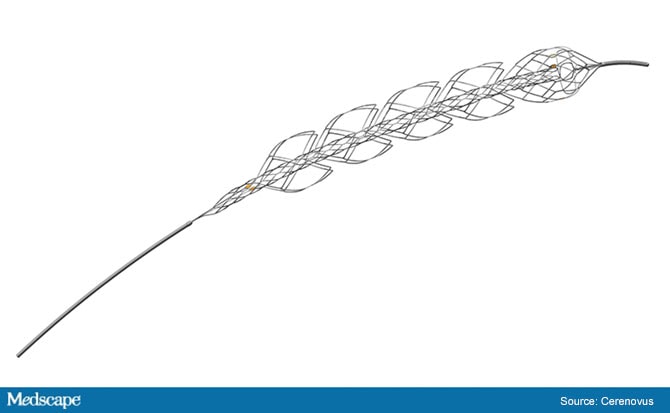LOS ANGELES — A new stent retriever with a novel design showed favorable rates of reperfusion, high rates of successful removal of the clot on the first attempt, and good clinical outcomes in a new uncontrolled single-arm study.
The device, EmboTrap (Cerenovus), is already available in Europe, and it is hoped that the current data will be sufficient for US Food and Drug Administration approval.
The ARISE II study was presented here at the International Stroke Conference (ISC) 2018 by Osama Zaidat, MD, Mercy Health St. Vincent’s Hospital, Toledo, Ohio.
“Current thrombectomy devices still fail to achieve successful reperfusion (mTICI flow ≥ 2b) in about one third of patients,” Dr Zaidat commented. “In ARISE II, the new EmboTrap device achieved mTICI 2b/3 flow within 3 passes — the primary endpoint — in 80% of patients, with 92% of patients eventually achieving this definition of successful reperfusion.”
In addition, the trial showed a high rate of success on the first attempt, with 51% of patients achieving mTICI (Modified Treatment in Cerebral Infarction) 2b/3 flow on the first pass, he noted. “These are very encouraging results.”
Commenting on the study for Medscape Medical News, Bruce Ovbiagele, MD, chair of the ISC 2018 meeting, agreed the trial has shown favorable reperfusion rates and functional outcomes.
“I think it is very promising, he said. “The main caveat is that this was a single-arm study — there are biases that might be there. We really need a randomized study to know for sure if this device is really better. But I think developing new, more effective stent retrievers should be the next focus to try to enhance the time to quality perfusion of the brain. If these reperfusion rates hold up in a randomized study, then it would be a great advance.”
Ralph Sacco, MD, Miller School of Medicine, Miami, Florida, noted that the field is now moving into third- and fourth-generation stent retrievers.
“We are getting more familiar with what causes clots in large-vessel occlusions in stroke, and as a result there are more effective devices being developed,” Dr Sacco, who was not involved in the research, told Medscape Medical News. “This new device seems to be good in terms of the numbers shown and it looks safe, but there was no comparison group. The next step would be to compare it to other devices.
“I would hope that we get to the stage where we have a panoply of different devices to select from that will be more adapted to individual conditions,” he added.
Dr Zaidat noted that the EmboTrap device has a novel design, “with an inner channel to allow for temporary bypass, an outer cage for clot-device interaction, and a distal protection zone.”

The ARISE II study involved 228 patients with ischemic stroke and a large-vessel occlusion with moderate to severe neurologic deficits and within 8 hours of symptom onset. Patients had an average age of 68 years and a mean National Institutes of Health Stroke Scale score of 15.5; 66% had received thrombolysis.
The primary endpoint — achievement of mTICI 2b or greater blood flow in the affected artery within three attempts of using the device — occurred in 80.2% of patients.
Table. Reperfusion Rates in ARISE II
| mTICI Score Within Three Passes of EmboTrap | Patients (%) |
|---|---|
| 3 | 43.6 |
| 2c | 21.1 |
| 2b | 15.4 |
| 2a | 5.3 |
| 1 | 2.6 |
| 0 | 10.6 |
In terms of clinical endpoints, 67.3% of patients had a good outcome at 90 days (mRS score of 0 to 2) and 51.6% achieved an excellent outcome (mRS score of 0 to 1).
The primary safety result — symptomatic intracerebral hemorrhage within 24 hours — occurred in 5.3% of patients. Embolization into new territory occurred in 6.6%, and the mortality rate was 9%.
Rescue therapy with a different type of device was used in 19% of patients.
“What is particularly striking to me in this study is the high first-pass efficacy,” where the clot is removed on the first attempt, co-principal investigator, Tommy Andersson, MD, Karolinska University Hospital, Stockholm, commented to Medscape Medical News.
This occurred in more than half of patients, he noted. “That is better than what we see in clinical practice with other devices — most of the time operators need at least two attempts to remove the clot. This means the procedure takes longer, as they have to reload everything, and as we all know, time is of the utmost importance,” Dr Andersson added. “With every failed attempt the clot becomes more difficult to remove. The goal is to get it out on the first attempt.”
Reperfusion rates have been improving steadily with new generations of stent retrievers, he added. “When these devices first came, out they were resulting in TICI 2b/3 flow rates of around 35% of patients. Now we are seeing rates of about 80%, but in this study we got up to a final rate of 92%.”
He explained that at operators normally have a favorite stent retriever that they use first in most patients. “But there are several new stent retrievers in the pipeline that are targeting different types of clot. In future we would probably have a few on the shelf and we would use different ones dependent on the individual clot or vasculature properties.”
The ARISE II study was funded by Cerenovus. Dr Zaidat has disclosed no relevant financial relationships.
International Stroke Conference (ISC) 2018. Abstract LB 5. Presented January 25, 2018.
For more Medscape Neurology news, join us on Facebook and Twitter
Tidak ada komentar:
Posting Komentar